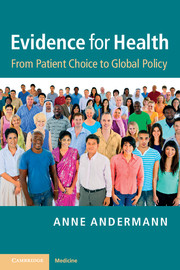Book contents
- Frontmatter
- Contents
- Foreword
- Preface
- Endorsements
- About the author
- Acknowledgments
- 1 Introduction
- 2 Strategies for improving health
- 3 Understanding how decisions influence health
- 4 Producing evidence to inform health decisions
- 5 Facilitators and barriers to using evidence
- 6 Making evidence-informed decisions
- 7 Conclusion
- Index
- References
7 - Conclusion
Published online by Cambridge University Press: 05 February 2013
- Frontmatter
- Contents
- Foreword
- Preface
- Endorsements
- About the author
- Acknowledgments
- 1 Introduction
- 2 Strategies for improving health
- 3 Understanding how decisions influence health
- 4 Producing evidence to inform health decisions
- 5 Facilitators and barriers to using evidence
- 6 Making evidence-informed decisions
- 7 Conclusion
- Index
- References
Summary
It is easy enough to propose an algorithm for making evidence-informed decisions to improve health, but the real challenge is putting it into practice. We have already discussed in Chapter 5 the various facilitators and barriers to using evidence in making decisions about health, and Chapter 6 describes the key elements that should be considered as part of the overall decision (i.e. the content), but it is important not to overlook how decisions are made and, in particular, who is involved (i.e. the process). In many ways, the process itself can be just as important as the content. This concluding chapter will therefore look at how to make evidence-informed decisions work in practice, as well as how to ensure that these decisions have the greatest possible impact on improving health.
Making it work in practice
It may appear self-evident, but decisions do not occur in some other realm and then are handed down to us mere mortals to abide by and follow. Rather, everything that structures our lives has been decided by people, and, if we want, these decisions could be changed to create a healthier and more equitable world. Indeed, the recent Rio +20 United Nations (UN) Conference on Sustainable Development asks: What is the Future We Want? Once we define our goals for the future, it is possible to change course and make it a reality. For instance, it was recently announced that “the [Millennium Development Goal (MDG)] drinking water target, which calls for halving the proportion of the population without sustainable access to safe drinking water between 1990 and 2015, was met in 2010, five years ahead of schedule”. Only two decades ago, almost one-quarter of the population on this planet did not have access to clean drinking water – one of the most basic necessities for health and daily life. Yet, with a concerted effort on the part of our global society, in 2010 there were only 11% left who still relied on unimproved sources of water – and that number is continually decreasing. That is not to say that no challenges remain. Nonetheless, it is quite remarkable what can change when the decision is made to make it happen. However, influencing decisions and ensuring that they are implemented requires involving a range of key players from the very outset.
- Type
- Chapter
- Information
- Evidence for HealthFrom Patient Choice to Global Policy, pp. 175 - 197Publisher: Cambridge University PressPrint publication year: 2012



